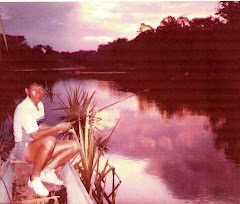The Iban Trackers
They fought alongside the British and other Commonwealth Forces in Malaya from 1948 to 1960. On August 8, 1948, 6 weeks after the Emergency was declared in Malaya, the first group of 49 Trackers were sent for a three months contract. By the end of the month, an additional 45 were sent. By October 1948, there were some 170 Iban Trackers attached to the various units.
Due to the expiry of their contract, by March 7, 1949, they all returned home.
However, in April 1949, another group of 40 arrived in Malaya and by December 1952, there were a total of 301 of them, and by that time too, some 1,168 Iban Trackers had served in Malaya. Of these, 8 were killed in action and another ten wounded. It was unfortunate that the Trackers were not a military unit and therefore not eligible for military honours and awards. Only Tracker Awang ak. Rawang and Tracker Menggong ak. Panggit were awarded the George Cross ( a civilian equivalent of the Victoria Cross) and the George Medal respectively.
In 1952, the Government of the Federation of Malaya had sought the consent of the Government of Sarawak to recruit Ibans for military services in Malaya, as opposed to their original role as civilian trackers. Consequently, in late 1952, two experimental platoons were formed and attached to British units for thorough training. These platoons were commanded by British Officers. The more experienced Ibans were appointed as non-commissioned officers.
On November 5, 1952, one of the platoons made its first kills when they killed two insurgents. On November 13, 1952, the other platoon was in action that resulted in Tracker Menggong ak.Panggit being awarded the George Medal.
The Sarawak Rangers
The Sarawak Rangers had an early beginning in 1862, when Rajah Charles Brooke found the need to have a standing army made up of Ibans. He believed that only Ibans can kill Ibans. The Sarawak Rangers became the nucleus of every expeditions he mounted against the rebellious Ibans. Rentap was finally beaten in his third expedition on the 3,000-feet Sadok mountain.
The Sarawak Rangers was the pride of the Rajahs. However, due to world economic recession of the 30s, it was disbanded. Some of its personnels were absorbed into the Sarawak Police Constabulary.
There was no record of its former members involvement in the War but it is believed that some of them were helping the Allied Troops working behind the enemy lines.
After the two successful experimental platoons, the Sarawak Government announced its intention to confer military status on all Iban Trackers serving in Malaya. Thus started the reformed Sarawak Rangers. However, the Sarawak Rangers Ordinance no. 22 of 1953 was not passed until 16 September 1953. The Sarawak Rangers was officially reformed with effect January 1, 1953. The Ibans were enthusiastic.
By this time, there were some 380 Sarawak Rangers deployed in Malaya. By 31 March 1960, Sarawak Rangers (Malayan Unit) was disbanded and a new unit, Sarawak Rangers (Far East Land Forces) was formed. Sarawak Rangers had became a part of the British Army and like her other units, it could serve anywhere in the world.
In the twelve years of fighting (1948 - 1960), the Iban Trackers and Sarawak Rangers were bestowed with:
One George Cross, one George Medal, one Military Medal, one British Empire Medal, nineteen Mentioned-In-Dispatches and Twenty-one Commander-In-Chief's Certificates.
The glory were, however, not without sacrifices. Twenty of their warriors were killed in action and 25 wounded. Considering that they were deployed as trackers and therefore forward most, these statistics are indeed impressive in any military records.
The dead were buried in Malaya (19) and Singapore (2).
Taking the iniative to bring the remains home and setting up a Heroes Memorial in Kuching, Sarawak.
November 6, 2008.
In conjunction with my book-launch by the Chief Minister of Sarawak, Pehin Sri Abdul Taib Mahmud, I brought up LCpl Ungkok's grave predicament and suggested at the same time to set up a Heroes Memorial and bring back all the remains of the Iban Trackers and Sarawak Rangers and rebury them in the Memorial.
The CM agreed but he said all the next-of-kins must give their consent.
The priority was to exhume and relocate LCpl Ungkok's grave which was located by the roadside in Jalan Langgar, Alor Setar, Kedah. I wrote to the Veterans Department in November 2008. After an initial dificulty, the grave was finally relocated to a Christian Cemetry nearby in Alor Setar on April 28, 2009.
After this phase has been successfully implemented, I then started on the big plan to bring home all the remains and relocate them in a Heroes Memorial in Kuching which will be set up.
April 30, 2009
I wrote to YB William Mawan ak. Ikom on the proposal to set up a Heroes Memorial and the plan to bring back all the Iban warriors from the Peninsula and Singapore.
May 3, 2009
I released the informations regarding the plan through a local paper, the Borneo Post on May 3, 2009 - the cutting is attached below.
Meantime, I'm working with a friend who has volunteered to assist me in getting more informations on the deceased - their home addresses and next-of-kins. This is to ensure a smooth and fast follow up actions later on.
As of now, there is nothing I can do, except keeping my fingers crossed and pray the plan can be realised for the good of the future generations of the Ibans.










